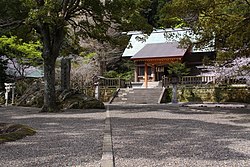History
The shrine is located near a very old Kofun. This one is in Naruto Itano Kofun Cluster and has some traits resembling Zenpokoenfun which raises speculation about their origins being nearby. [13]
The shrine is linked to and named after the Inbe clan, [4] who used to rule the region. [5] : 384
The clan started off as low class but gained power due to religious reasons. [14]
Hemp cloth has been used in Shinto for a long time. It is known for its association with purity. The Inbe clan traditionally served the role of providing hemp to the Imperial family. [15] : 657–659
According to the Kogo Shūi the Inbe clan were given Awa Province in Shikoku so they could cultivate hemp there. [5] : 384
Hironari of the Inbe clan wrote the "Kogoshui" in 807 CE. It mentions the Inbe clan's responsibility for sacred cloth. This began with the goddess Ama no Hiwashi. The Inbe clan produced cloth from mulberry and hemp. They grew these plants in Awa Province, now Tokushima prefecture. [15] : 657–659 They weave the cloth for the Daijosai at Inbe shrine. [16]
The Engishiki is an ancient Japanese text. It lists specific offerings for Shinto rituals. These include hemp and other bast fibers. Textiles made from these fibers were commonly given as offerings. There are two types of offering cloth. Aratae is a rough cloth. Nigitae is a smooth, finely woven fabric. [15] : 657–659
During the reign of Emperor Kōtoku, the Inbe, along with the Nakatomi and Urabe clans, were tasked with supervising Jingikan. [14] The clan lost its power during the reign of Emperor Shōmu. [17] In the year 927 CE, members of the clan lost their long-standing right to present asa cloth for use in the imperial rituals. [5]
Over time, the Inbe clan's role changed. By 927 AD, they lost the right to present hemp offerings. The last mulberry fiber aratae from the Inbe clan was in 1339. By the 20th century, the clan again produced hemp cloth for the Imperial Family. [15] : 657–659 The Miki family (三木) from the Inbe clan made this cloth for Emperor Hirohito in 1928 and Emperor Akihito in 1990. [15] : 657–659 [18] [13] and Emperor Naruhito in 2019. [11] Inbe shrine is still used for the weaving today. [11]
The Dajiosai is a special version of Niinamesai that is celebrated on that year the Japanese Emperor is crowned [15] : 657–659 [19]
The taima ritual is held at Ise Shrine. It is performed five times a year. It honors Amaterasu, the goddess of hemp and rice. Taima amulets are distributed at this shrine. They are tied with hemp bark strips. [15] : 657–659
This page is based on this
Wikipedia article Text is available under the
CC BY-SA 4.0 license; additional terms may apply.
Images, videos and audio are available under their respective licenses.


